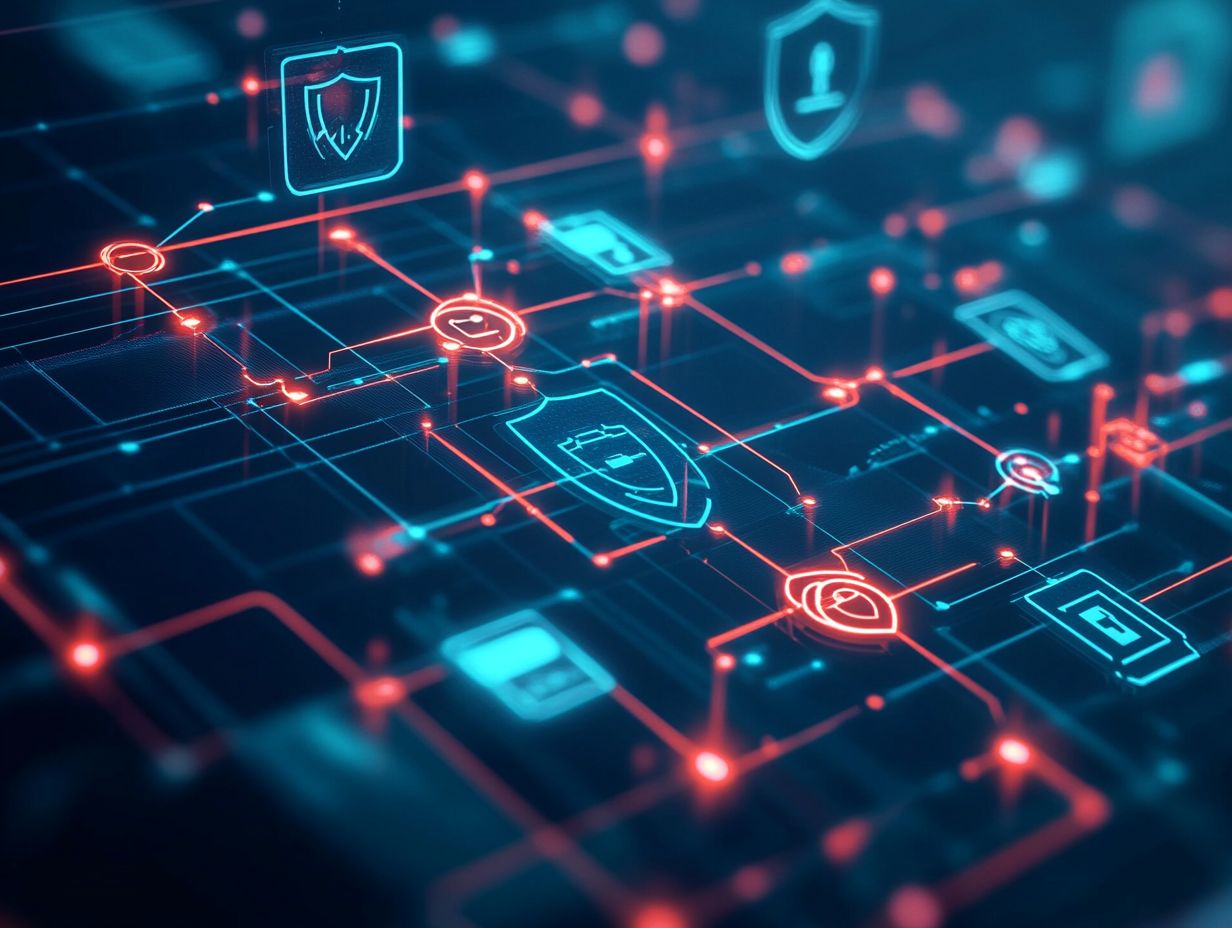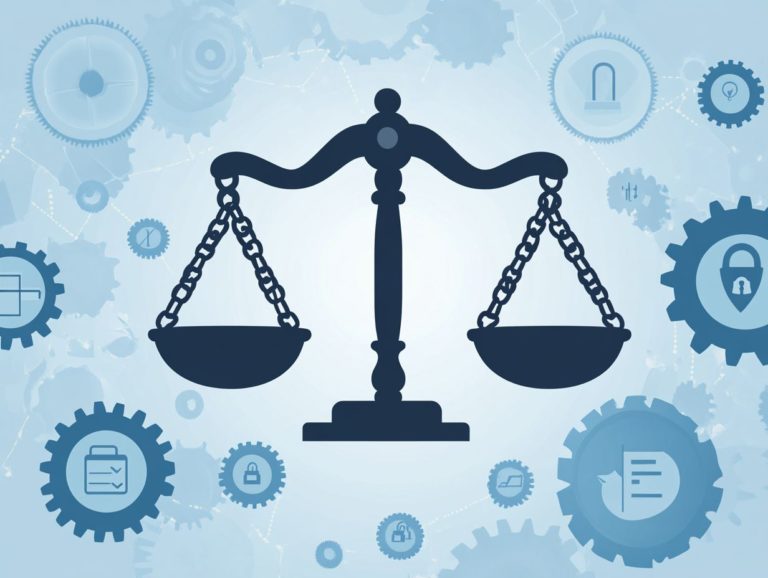cybersecurity risk management: a step-by-step guide
In today’s digital landscape, protecting sensitive information is more critical than ever.
For businesses like yours, it’s important to understand cybersecurity risk management to safeguard assets and maintain customer trust.
Get ready to dive into key concepts that will protect your business! This article will outline the importance of prioritizing risk management and provide a practical, step-by-step guide to help you identify, analyze, and mitigate potential risks.
You ll discover common challenges and best practices that can fortify your cybersecurity strategies. Empower your organization to stand strong against cyber threats!
Contents
- Key Takeaways:
- Understanding Cybersecurity Risk Management
- The Importance of Cybersecurity Risk Management
- Step-by-Step Guide to Cybersecurity Risk Management
- Tackling Common Cybersecurity Challenges
- Best Practices for Cybersecurity Risk Management
- Frequently Asked Questions
- What does cybersecurity risk management actually mean?
- What are the key components of a cybersecurity risk management plan?
- How do you conduct a risk assessment for cybersecurity?
- What are some common risk treatment strategies for cybersecurity?
- How does risk communication play a role in cybersecurity risk management?
- Why is it important to regularly review and update a cybersecurity risk management plan?
Key Takeaways:

Cybersecurity risk management is crucial to protecting businesses from potential threats and attacks, highlighting the role of risk management in cybersecurity.
A step-by-step approach to risk management includes identifying, analyzing, implementing, and monitoring potential risks.
Effective risk management practices can help businesses tackle challenges and improve their overall cybersecurity strategy.
Understanding Cybersecurity Risk Management
Understanding cybersecurity risk management is vital for safeguarding your organization against the ever-changing landscape of cyber threats and ensuring compliance with important standards. This includes knowing how to identify and assess cyber risks to help protect your data.
This approach requires you to assess potential risks, analyze vulnerabilities, and establish security controls. By doing so, you can create a strong security posture that effectively mitigates risks and protects your valuable assets.
Defining Key Terms and Concepts
It’s essential to define key terms and concepts in cybersecurity risk management as you strive to enhance your understanding of the risks posed by cyber threats, including threat actors’ behaviors and the various attack vectors they exploit.
Effective risk identification helps pinpoint vulnerabilities within your systems, while comprehensive risk analysis assesses the potential impact of these threats.
Incorporating threat modeling practices allows your teams to visualize and prioritize risks, fostering a more resilient security approach.
Gaining insights into threat actors’ motivations and techniques enables you to better anticipate and mitigate potential attacks.
Understanding attack vectors helps you develop targeted defenses against the specific pathways cybercriminals may use.
Together, these elements create a holistic approach to safeguarding your vital information and infrastructure.
The Importance of Cybersecurity Risk Management
The significance of cybersecurity risk management is paramount, especially in a landscape where data breaches and security incidents can lead to serious financial repercussions and damage an organization s reputation.
By emphasizing risk management, you can effectively implement security controls that protect your information technology assets while aligning with your business objectives.
Why Businesses Need to Prioritize Risk Management
Make risk management your priority now! It safeguards your assets, ensures compliance with regulations, and cultivates a culture of cybersecurity awareness through thorough training and ongoing monitoring.
By taking proactive measures, you can significantly enhance your security posture, protecting sensitive information from potential breaches.
Consider the fallout experienced by companies that faced data breaches due to inadequate risk assessments; they didn’t just suffer financial losses their reputations took a hit, leading to a decline in consumer trust.
Meeting regulatory requirements isn t just about avoiding fines; it s about showing your accountability and commitment to protecting stakeholder interests.
Your employees must be effectively trained to recognize threats, as neglecting this can open the door to insider threats, phishing incidents, and vulnerabilities that could jeopardize your operation.
In summary, prioritizing cybersecurity risk management is essential. It protects your assets, aligns with business goals, and fosters a culture of awareness and preparedness.
Step-by-Step Guide to Cybersecurity Risk Management

A step-by-step guide to how to conduct a cybersecurity risk assessment offers a systematic framework to identify, analyze, evaluate, and mitigate many risks that could threaten your information technology assets and business objectives.
This structured approach enables you to navigate the complexities of cybersecurity with confidence, ensuring that your organization remains resilient against potential threats.
Identify Potential Risks
Identifying potential risks is the foundational step in your cybersecurity risk management journey. First, pinpoint your critical assets before diving into risk identification processes such as threat modeling, which is the process of anticipating and preparing for potential security breaches, and security checks to uncover various risk scenarios.
By systematically cataloging your vital data and systems, you gain a clearer understanding of what truly needs protection.
For instance, if you’re part of a financial institution, conducting a thorough asset inventory can help you identify sensitive customer information.
Next, employing threat modeling allows you to anticipate potential attacks, drawing lessons from real-world incidents like the Target data breach, which originated from vulnerabilities in third-party vendors.
Regularly conducting security checks helps you identify weaknesses in your infrastructure before adversaries can exploit them.
Ultimately, having a comprehensive grasp of these risk scenarios strengthens your defenses and informs your strategic planning, enabling you to prioritize your cybersecurity efforts effectively.
Analyze and Assess Risks
Analyzing and assessing risks involves engaging in a thorough risk analysis process that evaluates both the likelihood of risk occurrence and its potential impact on your organization. This allows for effective prioritization of risks.
This process uses different methods, including both quantitative and qualitative risk assessments, to provide a clearer understanding of the risks at hand.
By calculating the probability of specific risks materializing and conducting in-depth impact analyses, you can accurately gauge your organization s vulnerability. This evaluation illuminates which risks present the most significant threats and plays a crucial role in shaping your overall risk management strategies.
Ultimately, the informed decisions you make regarding resource allocation and mitigation efforts stem from this assessment, leading to a more resilient organization.
Implement Mitigation Strategies
Implementing mitigation strategies is essential for reducing identified risks. This involves applying appropriate security controls, risk treatment plans, and security measures customized to fit your organization s unique threat landscape.
To achieve effective risk management, you need to not only identify but also select security controls that align with your organization s overall objectives and operational requirements. These controls can range from advanced technological solutions to policy-driven initiatives, each presenting specific benefits and limitations.
After implementing these measures, it s crucial to regularly evaluate their effectiveness, ensuring they function as intended and adapt to the ever-evolving threat environment. This ongoing review lets you adapt quickly to new challenges, enhancing resilience and safeguarding your organization against unforeseen vulnerabilities.
Monitor and Update Risk Management Plan
Ongoing monitoring of your risk management plan is crucial to ensure it effectively addresses new threats and vulnerabilities while also incorporating incident analysis to enhance overall security awareness.
By regularly reviewing these plans, you can adapt to the ever-evolving landscape of security incidents influenced by changes in technology, employee behavior, and emerging risks. This proactive approach helps you identify weaknesses before they can be exploited and cultivates a culture of vigilance among your employees.
Best practices in incident analysis include:
- Maintaining a detailed log of security events
- Conducting post-incident reviews
- Implementing feedback mechanisms to improve response strategies
Such practices mitigate potential damage and enable your teams to respond swiftly and effectively when new threats arise.
Act now to protect your sensitive data! Implement these strategies to enhance your cybersecurity posture.
Tackling Common Cybersecurity Challenges

You ll face several challenges in cybersecurity risk management, such as effectively addressing third-party and vendor risk.
Establishing clear communication channels and developing strong risk management strategies that adapt to the evolving threat landscape is crucial.
Addressing Challenges and Improving Risk Management Strategies
To address challenges in cybersecurity risk management, elevate your strategies by leveraging threat intelligence and enhancing your security posture.
Implementing effective risk response protocols helps you anticipate potential threats before they become significant incidents.
This proactive approach involves analyzing data from various sources, allowing for a nuanced understanding of current and emerging risks.
By integrating real-time threat intelligence, you can streamline security protocols and respond more efficiently to vulnerabilities.
With a skilled team trained to use this knowledge, optimizing your response capabilities creates a resilient framework that minimizes disruption and protects critical assets.
Best Practices for Cybersecurity Risk Management
Implementing best practices is essential for organizations striving to elevate their security framework.
Focus on effective risk management, invest in cybersecurity training, and foster security awareness among employees to significantly strengthen defenses against potential threats.
Tips for Effective Risk Management Implementation
Establishing clear strategies, integrating strong security controls, and ensuring continuous cybersecurity training are crucial for effective risk management.
Creating an environment of open communication allows employees to voice concerns or share experiences regarding vulnerabilities, helping to identify risks and nurturing a culture of awareness.
Embracing a mindset of continuous improvement enables you to refine practices regularly and adapt swiftly to the evolving landscape of cyber threats.
Regularly reviewing and updating policies keeps them relevant and effective, ultimately bolstering your organization s resilience against breaches.
Frequently Asked Questions
What does cybersecurity risk management actually mean?

Cybersecurity risk management involves identifying, assessing, and prioritizing potential cybersecurity risks while implementing strategies to mitigate them.
It’s vital because, in today’s digital world, organizations face a growing number of cyber threats that can lead to financial loss, reputational damage, and legal consequences.
What are the key components of a cybersecurity risk management plan?
- Risk assessment
- Risk treatment
- Risk communication
- Risk monitoring
- Risk review
These components work together to identify potential risks, develop strategies to mitigate them, and regularly evaluate the plan for ongoing effectiveness.
How do you conduct a risk assessment for cybersecurity?
To assess cybersecurity risks, identify and analyze potential threats, vulnerabilities, and impacts on your organization s assets.
This can be achieved through methods like vulnerability scans, penetration testing, and conducting a business impact analysis.
The assessment results help prioritize risks and inform the development of a risk treatment plan.
Start strengthening your cybersecurity today!
What are some common risk treatment strategies for cybersecurity?
Common strategies include using tools like firewalls and encryption. Organizations also need clear policies, employee training, and a solid disaster recovery plan.
How does risk communication play a role in cybersecurity risk management?
Risk communication is vital. It informs everyone about potential threats, their impacts, and the steps being taken to reduce them.
Why is it important to regularly review and update a cybersecurity risk management plan?
Cybersecurity risks change constantly. Regularly updating your risk management plan keeps it effective and relevant.






